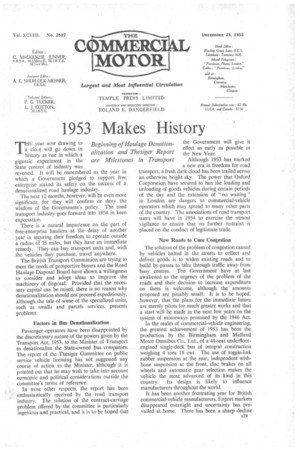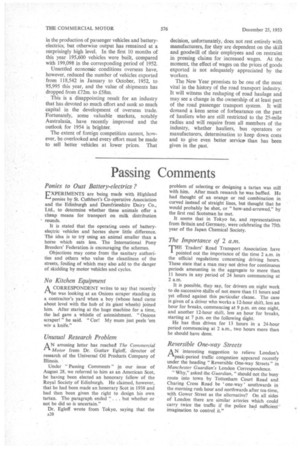1953 Makes History
Page 21

Page 22

If you've noticed an error in this article please click here to report it so we can fix it.
THE year now drawing to a do.:e will go down in history as one in which a gigantic experiment in the State control of industry was reversed. It will be remembered as the year in which a Government pledged to support free enterprise staked its safety on the success of a denationalized road haulage industry.
The next 12 months, however, will be even more significant, for they will confirm or deny the wisdom of the Government's policy. The road transport industry goes forward into 1954 in keen expectation.
There is a natural impatience on the part of free-enterprise hauliers at the delay of another year in securing their freedom to operate outside a radius of 25 miles, but they have an immediate remedy. They can buy transport units and, with the vehicles they purchase, travel anywhere.
The British Transport Commission are trying to meet the needs of prospective buyers and the Road Haulage Disposal Board have shown a willingness to consider and adopt ideas to improve the machinery of disposal. Provided that the necessary capital can be raised, there is no reason why denationalization should not proceed expeditiously, although the sale of some of the specialized units, such as smalls and parcels services, presents problems.
Factors in Bus Denationalization Passenger operators have been disappointed by the discretionary nature of the powers given by the Transport Act, 1953, to the Minister of Transport to denationalize the State-owned bus companies. The report of the Thesiger Committee on public service vehicle licensing has not suggested any course of action to the Minister, although it is pointed out that he may wish to take into account economic and political considerations outside the committee's terms of reference.
In most other respects, the report has been enthusiastically received by the road transport industry. The solution of the contract-carriage' problem offered by the committee is particularly ingenious and practical, and it is to be hoped that the Government will give it effect as early as possible in the New Year.
Although 1953 has marked a new era in freedom for road transport, a fresh dark cloud has been trailed across an otherwise bright sky. The power that Oxford Corporation have secured to ban the loading and unloading of goods vehicles during certain periods of the day and the extension of no waiting" in London are dangers to commercial-vehicle operators which may spread to many other parts of the country. The associations of road transport users will have in 1954 to exercise the utmost vigilance to ensure that no further restraint is placed on the conduct of legitimate trade.
New Roads to Cure Congestion The solution of the problem of congestion caused by vehicles halted in the streets to collect and deliver goods is to widen existing roads and to build by-passes to take through traffic away from busy centres. The Government have at last awakened to the urgency of the problem of the roads and their decision to increase expenditure on them is welcome, although the amounts proposed are pitiably small. It is to be hoped, however, that the plans for the immediate future are merely pilots for much greater works and that a start will be made in the next few years on the system of motorways promised by the 1946 Act.
In the realm of commercial-vehicle engineering, the greatest achievement of 1953 has been the production by the Birmingham and Midland Motor Omnibus Co., Ltd., of a 44-seat underfloorengined single-deck bus of integral construction weighing 4 tons 19 cwt. The use of toggle-link rubber suspension at the rear, independent wishbone suspension at the front, disc brakes on all wheels and automatic gear selection makes the vehicle the most advanced of its kind in this country. Its design is likely to influence manufacturers throughout the world.
It has been another frustrating year for British commercial-vehicle manufacturers. Export markets disappeared overnight and uncertainty has prevailed at home. There has been a sharp decline' in the production of passenger vehicles and batteryelectrics, but otherwise output has remained at a surprisingly high level. In the first 10 months of this year 195,600 vehicles were built, compared with 199,098 in the corresponding period of 1952.
Unsettled economic conditions overseas have. however, reduced the number of vehicles exported from 118,542 in January to October, 1952, to 95,995 this year, and the value of shipments has dropped from £72m. to £58m.
This is a disappointing result for an industry that has devoted so much effort and sunk so much capital in the development of overseas trade. Fortunately, some valuable markets, notably Australasia, have recently improved and the outlook for 1954 is brighter.
The extent of foreign competition cannot, however, be overlooked and every effort must be made to sell better vehicles at lower prices. That decision, unfortunately, does not rest entirely with manufacturers, for they are dependent on the skill and goodwill of their employees and on restraint in pressing claims for increased wages. At the moment, the effect of wages on the prices of goods exported is not adequately appreciated by the workers.
The New Year promises to be one of the most vital in the history of the road transport industry. It will witness the reshaping of road haulage and may see a change in the ownership of at least part of the road passenger transport system. It will demand a keen sense of forbearance on the part of hauliers who are still restricted to the 25-mile radius and will require from all members of the industry, whether hauliers, bus operators or manufacturers, determination to keep down costs and to give even better service, than has been given in the past.












































































